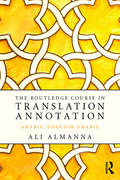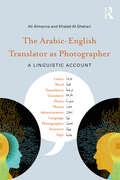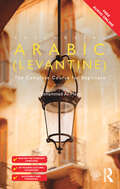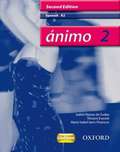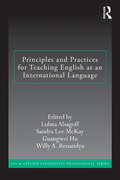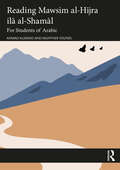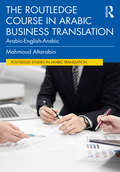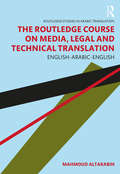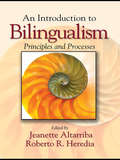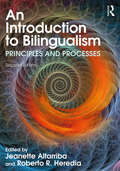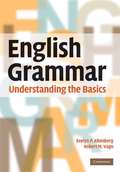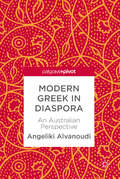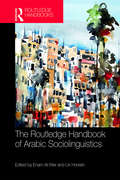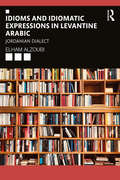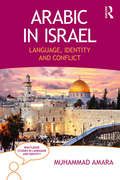- Table View
- List View
The Routledge Course in Translation Annotation: Arabic-English-Arabic
by Ali AlmannaThe Routledge Course in Translation Annotation: Arabic-English-Arabic is a key coursebook for students and practitioners of translation studies. Focusing on one of the most prominent developments in translation studies, annotation for translation purposes, it provides the reader with the theoretical framework for annotating their own, or commenting on others', translations. The book: presents a systematic and thorough explanation of translation strategies, supported throughout by bi-directional examples from and into English features authentic materials taken from a wide range of sources, including literary, journalistic, religious, legal, technical and commercial texts brings the theory and practice of translation annotation together in an informed and comprehensive way includes practical exercises at the end of each chapter to consolidate learning and allow the reader to put the theory into practice culminates with a long annotated literary text, allowing the reader to have a clear vision on how to apply the theoretical elements in a cohesive way The Routledge Course in Translation Annotation is an essential text for both undergraduate and postgraduate students of Arabic-English translation and of translation studies.
The Arabic-English Translator as Photographer: A Linguistic Account
by Ali Almanna Khaled Al-ShehariBy choosing to use different linguistic approaches as a theoretical basis of their study of translation as a process of picture-taking, The Arabic-English Translator as Photographer: A Linguistic Account offers readers an original view of the translator’s work. In addition to laying emphasis on the importance of giving full consideration to the mental image(s) conjured up in the mind of the translators, the book provides an accessible introduction to structural semiotics, interpretive semiotics, functional grammar, semantics and cognitive linguistics for students and researchers who are new to the field. The book can be used as a basis for (post)graduate students, especially students of MA and PhD in Translation Studies as well as students in modern languages schools. The book focuses on a specific pair of languages, English and Arabic, and presents the relationships generated by texts’ translation, including adverts and other types of texts, between these two languages.
Colloquial Arabic: The Complete Course for Beginners (Colloquial Series)
by Mohammad Al-MasriColloquial Arabic (Levantine) provides a step-by-step course in Levantine Arabic as it is used today. Combining a user-friendly approach with a thorough treatment of the language, it equips learners with the essential skills needed to communicate confidently and effectively in Levantine Arabic in a broad range of situations. No prior knowledge of the language is required. Key features include: progressive coverage of speaking, listening, reading and writing skills structured, jargon-free explanations of grammar an extensive range of focused and stimulating exercises realistic and entertaining dialogues covering a broad variety of scenarios useful vocabulary lists throughout the text additional resources available at the back of the book, including a full answer key and bilingual glossaries. Balanced, comprehensive and rewarding, Colloquial Arabic (Levantine) is an indispensable resource both for independent learners and students taking courses in Levantine Arabic. Colloquials are now supported by FREE AUDIO available online. All audio tracks referenced within the text are free to stream or download from www.routledge.com/cw/colloquials. Recorded by native speakers, the audio complements the book and will help enhance learners’ listening and speaking skills. By the end of this course, you will be at Level B1 of the Common European Framework for Languages and at the Intermediate-Low on the ACTFL proficiency scales.
Colloquial Arabic: The Complete Course for Beginners (Colloquial Series)
by Mohammad Al-MasriColloquial Arabic (Levantine) provides a step-by-step course in Levantine Arabic as it is used today. Combining a user-friendly approach with a thorough treatment of the language, it equips learners with the essential skills needed to communicate confidently and effectively in Levantine Arabic in a broad range of situations. No prior knowledge of the language is required. Key features include: progressive coverage of speaking, listening, reading and writing skills structured, jargon-free explanations of grammar an extensive range of focused and stimulating exercises realistic and entertaining dialogues covering a broad variety of scenarios useful vocabulary lists throughout the text additional resources available at the back of the book, including a full answer key and bilingual glossaries. Balanced, comprehensive and rewarding, Colloquial Arabic (Levantine) is an indispensable resource both for independent learners and students taking courses in Levantine Arabic. Colloquials are now supported by FREE AUDIO available online. All audio tracks referenced within the text are free to stream or download from www.routledge.com/cw/colloquials. Recorded by native speakers, the audio complements the book and will help enhance learners’ listening and speaking skills. By the end of this course, you will be at Level B1 of the Common European Framework for Languages and at the Intermediate-Low on the ACTFL proficiency scales.
Animo 2 Spanish A2: Student Book (2nd edition) (PDF)
by Alonso de Sudea, Isabel'Animo' provides a smooth transition from GCSE to A Level, with a diagnostic test to determine students' abilities, clear grammatical explanations and full practice and language learning strategies.
Principles and Practices for Teaching English as an International Language
by Lubna Alsagoff Sandra Lee Mckay Guangwei Hu Willy A. RenandyaWhat general principles should inform a socioculturally sensitive pedagogy for teaching English as an International Language and what practices would be consistent with these principles? This text explores the pedagogical implications of the continuing spread of English and its role as an international language, highlighting the importance of socially sensitive pedagogy in contexts outside inner circle English-speaking countries. It provides comprehensive coverage of topics traditionally included in second language methodology courses (such as the teaching of oral skills and grammar), as well as newer fields (such as corpora in language teaching and multimodality); features balanced treatment of theory and practice; and encourages teachers to apply the pedagogical practices to their own classrooms and to reflect on the effects of such practices. Designed for pre-service and in-service teachers of English around the world, Principles and Practices for Teaching English as an International Language fills a critical need in the field.
Principles and Practices for Teaching English as an International Language (ESL & Applied Linguistics Professional Series)
by Lubna Alsagoff Sandra Lee McKay Guangwei Hu Willy A. RenandyaWhat general principles should inform a socioculturally sensitive pedagogy for teaching English as an International Language and what practices would be consistent with these principles? This text explores the pedagogical implications of the continuing spread of English and its role as an international language, highlighting the importance of socially sensitive pedagogy in contexts outside inner circle English-speaking countries. It provides comprehensive coverage of topics traditionally included in second language methodology courses (such as the teaching of oral skills and grammar), as well as newer fields (such as corpora in language teaching and multimodality); features balanced treatment of theory and practice; and encourages teachers to apply the pedagogical practices to their own classrooms and to reflect on the effects of such practices. Designed for pre-service and in-service teachers of English around the world, Principles and Practices for Teaching English as an International Language fills a critical need in the field.
Reading Mawsim al-Hijra ilā al-Shamāl: For Students of Arabic
by Ahmad Alswaid Munther YounesReading Mawsim al-Hijra ilā al-Shamāl: For Students of Arabic is intended for advanced students of Arabic who have studied the language for at least two years at college level or the equivalent. The book is based on Tayeb Salih’s novel Mawsim al-Hijra ilā al-Shamāl, a masterpiece in modern Arabic literature. This book is designed to accompany the novel, which the authors divided into 60 parts, each of which consists of 400–500 words of the original text. A lesson is built on each part and starts with a reference to the first and last sentences in it. This is followed by a list of new vocabulary and a variety of activities and exercises, some oral and some written, whose goal is to develop students’ listening, speaking, reading, and writing skills and knowledge of Arabic language, culture, and literature. The book ends with a glossary of literary terms. The book’s e-resources include a comprehensive glossary of words arranged by root, a glossary of expressions, and other resources. The book can be used as a main or a supplementary text in an Arabic language course or for independent study.
Reading Mawsim al-Hijra ilā al-Shamāl: For Students of Arabic
by Ahmad Alswaid Munther YounesReading Mawsim al-Hijra ilā al-Shamāl: For Students of Arabic is intended for advanced students of Arabic who have studied the language for at least two years at college level or the equivalent. The book is based on Tayeb Salih’s novel Mawsim al-Hijra ilā al-Shamāl, a masterpiece in modern Arabic literature. This book is designed to accompany the novel, which the authors divided into 60 parts, each of which consists of 400–500 words of the original text. A lesson is built on each part and starts with a reference to the first and last sentences in it. This is followed by a list of new vocabulary and a variety of activities and exercises, some oral and some written, whose goal is to develop students’ listening, speaking, reading, and writing skills and knowledge of Arabic language, culture, and literature. The book ends with a glossary of literary terms. The book’s e-resources include a comprehensive glossary of words arranged by root, a glossary of expressions, and other resources. The book can be used as a main or a supplementary text in an Arabic language course or for independent study.
The Routledge Course in Arabic Business Translation: Arabic-English-Arabic (Routledge Studies in Arabic Translation)
by Mahmoud AltarabinThe Routledge Course in Arabic Business Translation: Arabic-English-Arabic is an essential coursebook for university students wishing to develop their skills in translating different types of business texts between English and Arabic. Practical in its approach, the book introduces translation students to the concept of translation and equivalence in the context of business texts, business translators, and the linguistic and syntactic features of business texts. It also highlights translation tools and technology in addition to the translation strategies which can be adopted to render business texts between English and Arabic. Key features in the book include: • Six comprehensive chapters covering (after the Introduction) the areas of economics, management, production, finance, and marketing in the translation industry; • Detailed explanation of the lexical and syntactic features of business texts; • Practical English and Arabic business translation texts featuring a vast business vocabulary bank; • Authentic business texts extracted from English and Arabic books containing economic, management, production, finance, and marketing texts; • Great range of English and Arabic translation exercises to enable students to practice their familiarity with business vocabulary they learned throughout the book; and • Glossaries following all English and Arabic business texts containing the translation of main vocabulary items. The practicality of the approach adopted in this book makes it an essential business translation coursebook for translation students. In addition, the carefully designed content helps students to easily explore different types of business texts, familiarize themselves with main words, and do translation exercises. University instructors working on English and Arabic business translations will find this book highly useful.
The Routledge Course in Arabic Business Translation: Arabic-English-Arabic (Routledge Studies in Arabic Translation)
by Mahmoud AltarabinThe Routledge Course in Arabic Business Translation: Arabic-English-Arabic is an essential coursebook for university students wishing to develop their skills in translating different types of business texts between English and Arabic. Practical in its approach, the book introduces translation students to the concept of translation and equivalence in the context of business texts, business translators, and the linguistic and syntactic features of business texts. It also highlights translation tools and technology in addition to the translation strategies which can be adopted to render business texts between English and Arabic. Key features in the book include: • Six comprehensive chapters covering (after the Introduction) the areas of economics, management, production, finance, and marketing in the translation industry; • Detailed explanation of the lexical and syntactic features of business texts; • Practical English and Arabic business translation texts featuring a vast business vocabulary bank; • Authentic business texts extracted from English and Arabic books containing economic, management, production, finance, and marketing texts; • Great range of English and Arabic translation exercises to enable students to practice their familiarity with business vocabulary they learned throughout the book; and • Glossaries following all English and Arabic business texts containing the translation of main vocabulary items. The practicality of the approach adopted in this book makes it an essential business translation coursebook for translation students. In addition, the carefully designed content helps students to easily explore different types of business texts, familiarize themselves with main words, and do translation exercises. University instructors working on English and Arabic business translations will find this book highly useful.
The Routledge Course on Media, Legal and Technical Translation: English-Arabic-English (Routledge Studies in Arabic Translation)
by Mahmoud AltarabinThe Routledge Course on Media, Legal and Technical Translation: English-Arabic-English is an indispensable and engaging coursebook for university students wishing to develop their English-Arabic-English translation skills in these three text types. Taking a practical approach, the book introduces Arab translation students to common translation strategies in addition to the linguistic, syntactic, and stylistic features of media, legal, and technical texts. This book features texts carefully selected for their technical relevance. The key features include: • comprehensive four chapters covering media, legal, and technical texts, which are of immense importance to Arab translation students; • detailed and clear explanations of the lexical, syntactic, and stylistic features of English and Arabic media, legal, and technical texts; • up-to-date and practical translation examples in both directions offering students actual experiences of professional translators; • authentic texts extracted from various sources to promote students’ familiarity with language features and use; • extensive range of exercises following each section of the book to enable students to test and practice the knowledge and skills they developed from reading previous sections; • glossaries following most exercises containing the translation of difficult words; and • a list of recommended readings following each chapter. The easy, practical, and comprehensive approach adopted in the book makes it a must-have coursebook for intermediate and advanced students studying translation between English and Arabic. University instructors and professional translators working on translation between English and Arabic will find this book particularly useful.
The Routledge Course on Media, Legal and Technical Translation: English-Arabic-English (Routledge Studies in Arabic Translation)
by Mahmoud AltarabinThe Routledge Course on Media, Legal and Technical Translation: English-Arabic-English is an indispensable and engaging coursebook for university students wishing to develop their English-Arabic-English translation skills in these three text types. Taking a practical approach, the book introduces Arab translation students to common translation strategies in addition to the linguistic, syntactic, and stylistic features of media, legal, and technical texts. This book features texts carefully selected for their technical relevance. The key features include: • comprehensive four chapters covering media, legal, and technical texts, which are of immense importance to Arab translation students; • detailed and clear explanations of the lexical, syntactic, and stylistic features of English and Arabic media, legal, and technical texts; • up-to-date and practical translation examples in both directions offering students actual experiences of professional translators; • authentic texts extracted from various sources to promote students’ familiarity with language features and use; • extensive range of exercises following each section of the book to enable students to test and practice the knowledge and skills they developed from reading previous sections; • glossaries following most exercises containing the translation of difficult words; and • a list of recommended readings following each chapter. The easy, practical, and comprehensive approach adopted in the book makes it a must-have coursebook for intermediate and advanced students studying translation between English and Arabic. University instructors and professional translators working on translation between English and Arabic will find this book particularly useful.
An Introduction to Bilingualism: Principles and Processes
by Jeanette Altarriba Roberto R. HerediaThis important text provides a general overview of the methods and theories used in the broad domain of bilingualism. The unique interdisciplinary approach, which is reflected in the various topics covered, gives students a global picture of the field. Topics range from early childhood intellectual development to educational and social-cognitive challenges to the maturing bilingual brain. Important developing areas such as cognitive aging, creativity, the social and cultural context perspective, communication disorders and sentence processing are also covered within the volume. This text is aimed towards undergraduate courses and graduate courses in psycholinguistics, especially those with an emphasis on bilingualism or second language learning.
An Introduction to Bilingualism: Principles and Processes
by Jeanette Altarriba Roberto R. HerediaThis important text provides a general overview of the methods and theories used in the broad domain of bilingualism. The unique interdisciplinary approach, which is reflected in the various topics covered, gives students a global picture of the field. Topics range from early childhood intellectual development to educational and social-cognitive challenges to the maturing bilingual brain. Important developing areas such as cognitive aging, creativity, the social and cultural context perspective, communication disorders and sentence processing are also covered within the volume. This text is aimed towards undergraduate courses and graduate courses in psycholinguistics, especially those with an emphasis on bilingualism or second language learning.
An Introduction to Bilingualism: Principles and Processes
by Jeanette Altarriba Roberto R. HerediaThe study of bilingualism and all of its aspects – from theory and models to social approaches and their practical applications – forms the cornerstone of the 2nd edition of this work. The chapters cover the latest advancements in the domains of psycholinguistics, neuroscience, creativity, and executive functioning. Contributions, new to this edition, offer the reader the most up-to-date research on lifespan and developmental issues. The work also provides insight into how human language is processed by all, not just by bilingual and multilingual speakers.This text is ideal for senior undergraduate and graduate courses in psycholinguistics and the psychology of language, especially those with an emphasis on bilingualism or second language learning.
English Grammar: Understanding The Basics
by Evelyn P. Altenberg Robert M. VagoLooking for an easy-to-use guide to English grammar? This handy introduction covers all the basics of the subject, using a simple and straightforward style. Students will find the book's step-by-step approach easy to follow and be encouraged by its non-technical language. Requiring no prior knowledge of English grammar, the information is presented in small steps, with objective techniques to help readers apply concepts. With clear explanations and well chosen examples, the book gives students the tools to understand the mysteries of English grammar as well as the perfect foundation from which to move on to more advanced topics.
Modern Greek in Diaspora: An Australian Perspective
by Angeliki AlvanoudiThis book presents an in-depth fieldwork-based study of the Greek language spoken by immigrants in Cairns, Far North Queensland, Australia. The study analyzes language contact-induced changes and code switching patterns, by integrating perspectives from contact linguistics and interactional approaches to language use and code switching. Lexical and pragmatic borrowing, code mixing, discourse-related and participant-related code switching, and factors promoting language maintenance are among the topics covered in the book. The study brings to light original data from a speech community that has received no attention in the literature and sheds light on the variation of Greek spoken in diaspora. It will appeal across disciplines to scholars and students in linguistics, anthropology, sociology, and migration studies.
Modern Greek in Diaspora (PDF)
by Angeliki AlvanoudiThis book presents an in-depth fieldwork-based study of the Greek language spoken by immigrants in Cairns, Far North Queensland, Australia. The study analyzes language contact-induced changes and code switching patterns, by integrating perspectives from contact linguistics and interactional approaches to language use and code switching. Lexical and pragmatic borrowing, code mixing, discourse-related and participant-related code switching, and factors promoting language maintenance are among the topics covered in the book. The study brings to light original data from a speech community that has received no attention in the literature and sheds light on the variation of Greek spoken in diaspora. It will appeal across disciplines to scholars and students in linguistics, anthropology, sociology, and migration studies.
The Routledge Handbook of Arabic Sociolinguistics
by Enam Al-Wer Uri HoreshThe Routledge Handbook of Arabic Sociolinguistics comprises 22 chapters encompassing various aspects in the study of Arabic dialects within their sociolinguistic context. This is a novel volume, which not only includes the traditional topics in variationist sociolinguistics, but also links the sociolinguistic enterprise to the history of Arabic and to applications of sociolinguistics beyond the theoretical treatment of variation. Newly formed trends, with an eye to future research, form the backbone of this volume. With contributions from an international pool of researchers, this volume will be of interest to scholars and students of Arabic sociolinguistics, as well as to linguists interested in a concise, rounded view of the field.
The Routledge Handbook of Arabic Sociolinguistics
by Enam Al-Wer Uri HoreshThe Routledge Handbook of Arabic Sociolinguistics comprises 22 chapters encompassing various aspects in the study of Arabic dialects within their sociolinguistic context. This is a novel volume, which not only includes the traditional topics in variationist sociolinguistics, but also links the sociolinguistic enterprise to the history of Arabic and to applications of sociolinguistics beyond the theoretical treatment of variation. Newly formed trends, with an eye to future research, form the backbone of this volume. With contributions from an international pool of researchers, this volume will be of interest to scholars and students of Arabic sociolinguistics, as well as to linguists interested in a concise, rounded view of the field.
Idioms and Idiomatic Expressions in Levantine Arabic: Jordanian Dialect
by Elham AlzoubiIdioms and Idiomatic Expressions in Levantine Arabic: Jordanian Dialect is a unique resource for intermediate and advanced learners of Arabic. The book contains over 2000 of the most common idioms and idiomatic expressions used in Levantine Arabic–Jordanian dialect. Each idiom is presented with a sample sentence or dialogue, which provides the authentic sociocultural context necessary to better understand how to use each idiomatic expression appropriately. Ideal for students studying Levantine/Jordanian Arabic or planning to study and/or live in Jordan or the Levant, this book provides learners with a wealth of basic vocabulary and structures that will raise their meta-linguistic awareness of Arabic in general and Jordanian Arabic in particular.
Decadent Literature in Twentieth-Century Japan: Spectacles Of Idle Labor
by I. AmanoDecadence is a concept that designates a given historical moment as a phase of decay and valorizes the past as an irretrievable golden age. This study offers an innovative examination of a century of Japanese fiction through the analytical prism of decadence.
Arabic in Israel: Language, Identity and Conflict (Routledge Studies in Language and Identity)
by Muhammad AmaraIn Arabic in Israel, Muhammad Amara analyses the status of Arabic following the creation of the State of Israel and documents its impact on the individual and collective identity of Israel’s Palestinian Arab citizens. The interplay of language and identity in conflict situations is also examined. This work represents the culmination of many years of research on Arabic linguistic repertoire and educational policy regarding the language of the Palestinian citizens of Israel. It draws all of these factors together while linking them to local, regional and global developments. Its perspective is interdisciplinary and, as such, examines the topic from a number of angles including linguistic, social, cultural and political.
Arabic in Israel: Language, Identity and Conflict (Routledge Studies in Language and Identity)
by Muhammad AmaraIn Arabic in Israel, Muhammad Amara analyses the status of Arabic following the creation of the State of Israel and documents its impact on the individual and collective identity of Israel’s Palestinian Arab citizens. The interplay of language and identity in conflict situations is also examined. This work represents the culmination of many years of research on Arabic linguistic repertoire and educational policy regarding the language of the Palestinian citizens of Israel. It draws all of these factors together while linking them to local, regional and global developments. Its perspective is interdisciplinary and, as such, examines the topic from a number of angles including linguistic, social, cultural and political.
